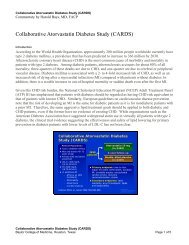Relationship of Glycemia to Cardiovascular Disease ... - Lipids Online
Relationship of Glycemia to Cardiovascular Disease ... - Lipids Online
Relationship of Glycemia to Cardiovascular Disease ... - Lipids Online
Create successful ePaper yourself
Turn your PDF publications into a flip-book with our unique Google optimized e-Paper software.
UKPDS: Hemoglobin A 1c and Rates for Myocardial<br />
Infarction and Microvascular Complications<br />
Adjusted Incidence per<br />
1,000 Person Years (%)<br />
80<br />
60<br />
40<br />
20<br />
Myocardial infarction<br />
Microvascular endpoints<br />
0<br />
5 6 7 8 9 10 11<br />
Updated Mean HbA 1c Concentration<br />
HbA 1c = hemoglobin A 1c (glycosylated)<br />
UKPDS = United Kingdom Prospective Diabetes Study<br />
Strat<strong>to</strong>n IM, et al. BMJ. 2000;321:405–412; reproduced<br />
with permission from the BMJ Publishing Group.<br />
Slide Source<br />
<strong>Lipids</strong> <strong>Online</strong> Slide Library<br />
www.lipidsonline.org<br />
UKPDS: Hemoglobin A 1c and Rates for Myocardial Infarction and Microvascular<br />
Complications<br />
In United Kingdom Prospective Diabetes Study, which examined the updated mean<br />
hemoglobin A 1c (HbA 1c ) on treatment and the incidence <strong>of</strong> both myocardial infarction<br />
(MI) and microvascular endpoints, there were graded increases across glycemia for the<br />
risk <strong>of</strong> these end-organ complications. The risk <strong>of</strong> microvascular disease was much<br />
greater than the risk for MI at the same HbA 1c concentration. These data support<br />
observations, over the years, that reductions in HbA 1c with treatment could produce<br />
robust decreases in microvascular endpoints. The slope <strong>of</strong> the curve <strong>of</strong> glycemic control<br />
related <strong>to</strong> MI risk is not as steep, indicating that if intervention is <strong>to</strong> be successful in<br />
reducing MI risk, then larger decreases in HbA 1c may be required. Of note is the fact that<br />
across the range <strong>of</strong> HbA 1c concentrations from 5.5% <strong>to</strong> 9.5%, the absolute risk for MI<br />
was greater than the risk for the development <strong>of</strong> microvascular disease. The mechanism<br />
by which glycemia increases risk for vascular disease has been the subject <strong>of</strong> intense<br />
scrutiny.<br />
Reference:<br />
Strat<strong>to</strong>n IM, Adler AI, Neil HA, et al. Association <strong>of</strong> glycaemia with macrovascular and<br />
microvascular complications <strong>of</strong> type 2 diabetes (UKPDS 35): prospective observational<br />
study. BMJ. 2000;321:405-412.<br />
Source: <strong>Lipids</strong> <strong>Online</strong> Slide Library (www.lipidsonline.org) Page 4 <strong>of</strong> 36<br />
© 2009 Baylor College <strong>of</strong> Medicine, Hous<strong>to</strong>n, Texas



